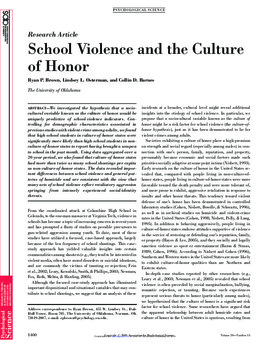| dc.contributor.author | Ryan P. Brown | |
| dc.contributor.author | Lindsey L. Osterman | |
| dc.contributor.author | Collin D. Barnes | |
| dc.date.accessioned | 2016-01-14T19:52:53Z | |
| dc.date.accessioned | 2016-03-30T15:35:11Z | |
| dc.date.available | 2016-01-14T19:52:53Z | |
| dc.date.available | 2016-03-30T15:35:11Z | |
| dc.date.issued | 2009-11-01 | |
| dc.identifier.citation | Brown, R. P., Osterman, L. L., & Barnes, C. D. (2009). School Violence and the Culture of Honor. Psychological Science, 20(11), 1400-1405. doi: 10.1111/j.1467-9280.2009.02456.x | en_US |
| dc.identifier.uri | https://hdl.handle.net/11244/24950 | |
| dc.description.abstract | We investigated the hypothesis that a sociocultural variable known as the culture of honor would be uniquely predictive of school-violence indicators. Controlling for demographic characteristics associated in previous studies with violent crime among adults, we found that high-school students in culture-of-honor states were significantly more likely than high-school students in non-culture-of honor states to report having brought a weapon to school in the past month. Using data aggregated over a 20-year period, we also found that culture-of honor states had more than twice as many school shootings per capita as non-culture-of-honor states. The data revealed important differences between school violence and general patterns of homicide and are consistent with the view that many acts of school violence reflect retaliatory aggression springing from intensely experienced social-identity threats. | en_US |
| dc.language.iso | en_US | en_US |
| dc.publisher | Psychological Science | |
| dc.title | School Violence and the Culture of Honor | en_US |
| dc.type | Research Article | en_US |
| dc.description.peerreview | Yes | en_US |
| dc.description.peerreviewnotes | https://us.sagepub.com/en-us/nam/manuscript-submission-guidelines | en_US |
| dc.identifier.doi | 10.1111/j.1467-9280.2009.02456.x | en_US |
| dc.rights.requestable | false | en_US |
